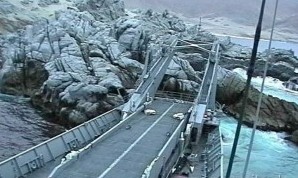There has been a lot of static on the net lately concerning acquisition reform. Two notable recent arrivals on the scene have been all the buzz around the Beltway: First, the release of Better Buying Power (BBP) 3.0, Under Secretary of Defense (AT&L) Frank Kendall’s reincarnation of BBP 1.0 (originally issued by Ash Carter when AT&L, and later BBP 2.0 by Mr.Kendall).  Second was the publishing of a report by the Senate Permanent Subcommittee on Investigations, Chaired by Senator Levin, with Senator McCain as the Ranking Member. The report, entitled “Defense Acquisition Reform: Where Do We Go From Here?, is a collection of essays by 30 experts in the Defense acquisition world about how to improve or reform defense acquisition of things (and to a small degree, services).
Second was the publishing of a report by the Senate Permanent Subcommittee on Investigations, Chaired by Senator Levin, with Senator McCain as the Ranking Member. The report, entitled “Defense Acquisition Reform: Where Do We Go From Here?, is a collection of essays by 30 experts in the Defense acquisition world about how to improve or reform defense acquisition of things (and to a small degree, services).
One of the things I like most about the concept of the Better Buying Series is the iterative process in improving its focus. After letting BBP 1.0 run for a while, corrections were needed as the result of some unintended consequences (like an irrational focus on lowest price, technically acceptable contracts) and need for clarification of some of the elements. BBP 2.0 did just that, directing that more care must be given in defining what is “technically acceptable” for example. Now, BBP 3.0 has come out to further tweak the elements of BBP. A couple of previous elements were eliminated because they were considered complete:
- Institute a system to measure the cost performance of programs and institutions and to assess the effectiveness of acquisition policies
- Assign senior managers for acquisition of services
There were some carry overs as well, mostly with refined language. I won’t list them all here, but the ones that I think represent the most significant change are:
- A recognition that capability must be considered in evaluating cost by changing the focus from “Control Costs Throughout the Product Lifecycle” to “Achieve Dominant Capabilities while Controlling Lifecycle Costs”
- Expanding focus on incentivizing productivity and innovation by breaking out into separate areas with following additions:
- Increase prototyping and experimentation
- Emphasize tech insertion and refresh in program planning
- Use of modular, open architecture systems
- Provide tech requirements to industry early
- Increasing ability of acquisition leaders to understand and mitigate technical risk.
- Increased support for Science, Technology, Engineering and Mathematics (STEM) education
Here’s a link to the BBP 3.0 overview. All in all I think it represents a good step forward in the BBP series and will certainly help in trying to understand all the things going on in the world of acquisition reform……..BUT,
Many of the themes that emerged in the second recent arrival, the Senate study (Complete study can be found here) were not really addressed in the BBP 3.0 document. To be fair, the report had yet to be released prior to putting BBP 3.0 on the street, but I would have hoped for more overlap.
The Senate report pulled out four overarching themes from the musings of the 30 experts contributing to the report:
- A cultural change is needed in the acquisition workforce, including more effective incentives
- Training and recruiting of the acquisition workforce must be improved
- Realistic requirements definition are critical
- Accountability and leadership throughout product life-cycle needs improvement
The report also makes two observations which I will quote here:
“First, among all those factors that have been identified as contributing to dysfunction in the defense acquisition system, cultural change is among both the most important and the least amenable to legislation and policy changes. It is, rather, a function of leadership throughout the chain-of-command and an incentive structure that threads through both the government contracting and acquisition workforce and industry that assigns a premium to cost-control and the timely delivery of needed capability.
Second, continued “sequestration” of the DOD’s budgets will undermine any savings that could be achieved through even the most successful acquisition reform.”
Well, to me that says, 1. It’s more of a DoD problem than a legislative problem and 2. sequestration will nullify ( or at least severely impact) all acquisition reform efforts. The last thing we need is even more regulation in the acquisition process. I would offer that in my opinion sequestration is not necessarily the enemy here. I still think we have too much waste in DoD, too many pork barrel projects, too many pet projects and too many cooks in the kitchen. What is the enemy is the uncertainty in the budget process over the last several years….Continuing Resolutions, multiple budgets, Overseas Contingency Funds abuse and a foolish focus on equity in Service budgets have all undermined our ability to reform how we buy things. In the end, it is a indeed a legislative problem….The failure to pass budgets on time, regardless of the funding levels. Life would be so much easier and efficient in DoD acquisition with regular and predictable budgets, passed in a timely fashion and accurately executed.
One final observation: I would like to see the Senate produce a similar document on acquisition reform, but using 30 PRACTITIONERS of acquisition at the grass roots level: Project Managers, PEOs, and Contracting Officers. A view from the top is always useful, but without a view from the bottom we will never really fix what is wrong with acquisition culture. They are the ones that make up the culture, not the poobahs at the top. A little more focus on them would be helpful…I’m not sure that after a contacting officer reads BBP 3.0 they will do anything different.




 Granted they do make a few hard choices, but none of them are the budget choices they are making for the FY15 budget that’s on the Hill right now. They have so much money to deal with that the normal ways in which you or I would deal with problems is not possible. There are several reasons why I believe the tough choices are not possible. In fact, in the Pentagon the toughest choices are actually the easiest. Take for example the luxury of scale. Because of the vast quantity of money the Pentagon has, scale makes things easy. Let’s just say for the sake of argument that the total Pentagon budget for 2015 will be around $550 Billion. I’m working on the budget and I need to come up with $5oo million to pay for my “widget ” program because it’s two years behind schedule and Congressional support is waning. I dare not go to the Hill and ask for more money. What tough choices can I make? How about I assume the inflation rate for next year will be 0.1% less than it currently is….Guess what? Instant $550 Million in my pocket. Problem solved!
Granted they do make a few hard choices, but none of them are the budget choices they are making for the FY15 budget that’s on the Hill right now. They have so much money to deal with that the normal ways in which you or I would deal with problems is not possible. There are several reasons why I believe the tough choices are not possible. In fact, in the Pentagon the toughest choices are actually the easiest. Take for example the luxury of scale. Because of the vast quantity of money the Pentagon has, scale makes things easy. Let’s just say for the sake of argument that the total Pentagon budget for 2015 will be around $550 Billion. I’m working on the budget and I need to come up with $5oo million to pay for my “widget ” program because it’s two years behind schedule and Congressional support is waning. I dare not go to the Hill and ask for more money. What tough choices can I make? How about I assume the inflation rate for next year will be 0.1% less than it currently is….Guess what? Instant $550 Million in my pocket. Problem solved!

 There has been a lot about leadership in the news lately (
There has been a lot about leadership in the news lately (